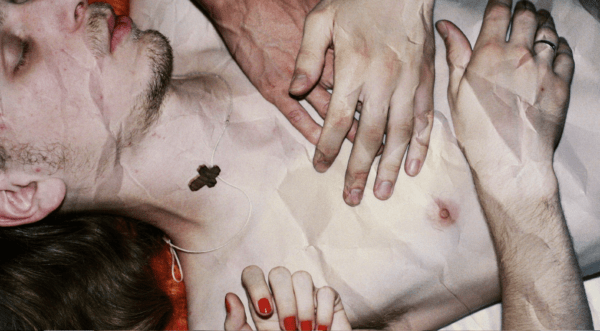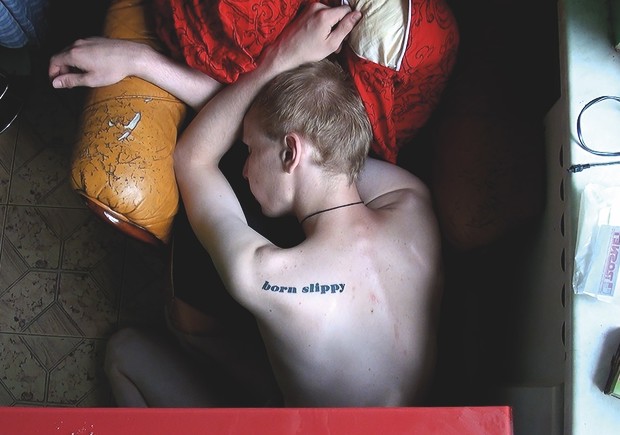
How to Save a Dead Friend is Marusya Syroechkovskaya’s compelling documentary about young love for a lost generation in Putin’s grim Russia. Filmed by herself and her partner Kimi over a twelve-year period, we follow the couple as they deal with the severe challenges affecting them and their network of friends which include suicide, drug and alcohol addiction, unemployment, and mental health problems.
Russia has long had severe societal issues. It has the highest rate of alcoholism in the world, the third highest rate of drug addiction, and the ninth-highest rate of suicide. Russian life expectancy ranks 113rd in the world, with an average male life expectancy of just 68, lower than that of North Korea or Bangladesh. Putin’s repressive regime is making things worse and it’s against this backdrop that we first meet sixteen-year-old Marusya as she begins documenting her depressed, suicidal life in Moscow in 2005. Back then, she assumes her sixteenth year will be her last in ‘Depression Federation’ as she refers to her homeland. She uses a variety of means to self-harm, including scissors, sharp paper edges, pins, rulers, and even her own sharpened fingernails. Suicide is never far from her mind as she stares from the windows of her cold-war-era Soviet housing apartment block during the bleak snowy Russian winters. Many of her friends have committed suicide, using a variety of methods including guns and drug overdoses. She feels she will be next and is obsessed with the prospect.
 Then one night at a grunge party she meets Kimi. Charismatic Kimi is kind, handsome, with long blonde hair, an animal lover, has a dry sense of humor, loves Nirvana and knows the lyrics to every Joy Division track. In short, the perfect man for her. The two start hanging out together, and, slowly, with Kimi’s continuous support, Marusya’s suicidal feelings dissipate.
Then one night at a grunge party she meets Kimi. Charismatic Kimi is kind, handsome, with long blonde hair, an animal lover, has a dry sense of humor, loves Nirvana and knows the lyrics to every Joy Division track. In short, the perfect man for her. The two start hanging out together, and, slowly, with Kimi’s continuous support, Marusya’s suicidal feelings dissipate.
We follow the poetic couple over the next twelve years or so as they navigate Putin’s Russia and deal with each-other’s mental health issues, drug and alcohol abuse and those of their friends. Their journey takes them from a youthful honeymoon period of underground clubs and music through to marriage and divorce. The film documents Marusya’s relative recovery and Kimi’s downward spiral into drug addiction and mental illness. Marusya grew up in a middle-class household so poverty was not a trigger for her issues. Kimi’s swimming coach father died when he was nine, leaving his mother Tatjana, also a swimming coach, to bring up three children as a single mom. Kimi recalls there often being no food at all in the fridge and having to learn that a cup of tea with ten sugars would give him enough energy to face the day. He did however have warm love from his mother. His mother joins Marusya in trying to help Kimi recover, and Kimi eventually moves back home to join her and his older brother, who is also a drug addict.
Marusya combines striking cinematography of bleak mid-Winter Russia with very personal up-close footage to tell her story. The truly excellent soundtrack includes Joy Division’s ‘Love will tear us apart’ and Hole’s ‘Rock Star’ amongst many other great tracks. It’s very rare for a documentary to follow its subjects so closely for such a long period, and we can see Marusya’s film-making skills improve as the film progresses. Now living in exile, her film gives a rare insight into daily life for many Russians – Putin’s lost generation of the 2000’s, and despite the often-tough subject matter, the underlying current of soul-mates in love makes the film extremely watchable.
PS We reviewed the movie at DOC NYC where is won Grand Jury Prize/ Int'l competition For future screenings check out https://www.facebook.com/HowToSaveADeadFriend
Queerguru’s Contributing Editor Ris Fatah is a successful fashion/luxury business consultant (when he can be bothered) who divides and wastes his time between London and Ibiza. He is a lover of all things queer, feminist, and human rights in general. @ris.fatah

